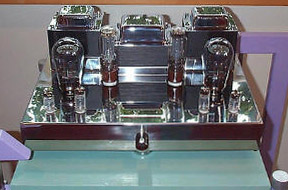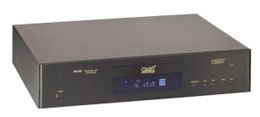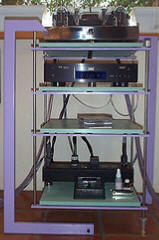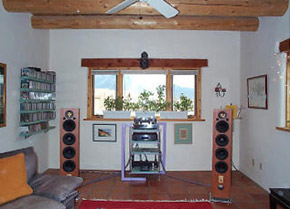![[SoundStage!]](../sslogo3.gif) Earmarked! Earmarked!Back Issue Article |
|
March 2001 This Writer's System 1960s: Carlos Castaneda meets Don Juan Matus. This encounter with age-old Yaqui Indian sorcery soon turns life-altering personal commitment to break the habitual force of attention and shift perception into subtler realms of reality. Today, would-be Castanedians might attempt to seek out Florinda Donner or Taisha Abelar, two female masters in Don Juan’s tradition who may or may not accept disciples if you manage to even locate them. The possibility definitely lures. 1920s: An entire Parisian retinue of expatriate intellectuals, amongst them Gertrude Stein, James Joyce, Kiki and Man Ray, Josephine Baker and Ernest Hemingway, unknowingly pre-visit the counter culture of the '60s. Alice B. Toklas creates the original recipe for this Lost Generation’s hashish-laced brownies. Present-day liberal bistros in Amsterdam offer similarly spiked delights. How much resemblance they bear to Toklas’ originals is questionable. However, those so inclined can readily find the by-ingredient recipe in her writings. Time-travel to the Bohemian flavor of Paris in the '20s and re-create the forbidden pleasure in the privacy of your own culinary crucible. Another enchanted option. Also 1920s: GEC introduces the ultralinear triode PX-25 as an alternative to the popular 2A3. When a new breed of tetrodes with an extra grid and higher output power comes into vogue -- their closest present-day equivalent would be a KT-66 -- the PX-25 disappears at the end of World War II. Unlike our previous examples, this particular journey -- into the peculiar magic of an aural aroma instead of mental visions or consciousness transference -- seems distinctly no longer retraceable. The door has closed for good. Even were rare NOS samples to surface here and there, no amps exist to plug them into. Earresistible if you’re into tubes Forward to year 2000: Riccardo Kron of KR Enterprise in the Czech Republic reissues the PX-25, probably much to the consternation of valve-amp manufacturers who don’t exactly know what to do with this tube. Existing circuits don’t fit. Neither do stock transformers. While the promise of a "super 2A3" with its magic midrange but now vastly improved frequency extremes must entice the designers -- at least in theory -- who will perform the requisite groundwork, study the tube’s contemporary potential and learn about its circuit and transformer requirements in truly intimate researcher’s fashion? Cut to different scene.A new column "Earmarked!" is a new place where I will share with you my personal aural excursions into different gear and tweaks. It is said, wisely, that the journey of a thousand miles begins with a few steps. It is also said that sometimes, to proceed forward with insight, one should first take a few steps backwards. To follow me along this column’s journey, it will be instructive to learn about the beginning. It constitutes the background against which future audio experiments will unfold. Let’s go back then in time momentarily to appreciate how my system has continued to evolve since I first began writing for SoundStage! about two years ago. In my system today, you will recognize many components that have made past appearances in my -- ongoing, don’t worry -- "Y-Files." The reason’s simple. I investigated these products because I was drawn to them. I responded to what I sensed they were about. Call it a certain allure. My idiosyncratic audiophile persona; my past as a classically trained musician; my well-known Jones for single-ended tubes; probably other influences, beliefs and biases as well I’m not cognizant about; all compelled me. When these components satisfied my sonic requirements, some of them became constant traveling companions. In all cases, I only wrote about them after I was satisfied that I had discovered something worthy of sharing. Why waste bad ink if you’re not a formal reviewer who must cover pre-assigned gear? Synergy Marc Mickelson, in last month’s review of the Bel Canto EVo 200.2, remarked in his intro how, if you’re into tubes, one sometimes builds an entire system -- especially in the choice of speakers -- around a particular amplifier. After my 1999 review of the Art Audio Jota, I came across the Triangle Lyrr XS speakers and, during their review, noted a very overt and extremely appealing synergy between both components. When I approached the speakers’ importer, Richard Kohlruss, to sell me the Lyrrs, he resisted and advised to wait. An even better model dubbed the Ventis XS was about to launch. I acceded and subsequently purchased them over the Lyrrs, with the clear intent to permanently join them in sacred matrimony to the Jota that had never left since its review concluded. Ah, audiophile delusions. Soon a friend who owned a Jota alerted me to a new Art Audio amp. With the right speakers -- at 93dB sensitivity, mine distinctly fit the mold, good grief -- he claimed the newcomer was even better. In fact, he’d sold the Jota to his dad and purchased the new amp, subsequently adjusting to its reduced power output with a pair of Reference 3A’s top-line Suprema speakers. I rang the amp manufacturer and requested a sample of this upstart myself. Sacred marriage my rear. If this thing lifted my kilt as my friend warned it would, I’d break yet another audiophile vow in a long succession of previous ones. Cut back to first scene. The PX-25 valve The right answer to who would first rise to its intrinsic challenge is Joe Fratus. Of all engineers currently working the thermionic amplifier bench, Art Audio’s US importer and contributing designer is the only one yet to have developed a dedicated circuit and matching transformers to tap the magic of this lost-and-found-again wide-bandwidth triode. Before we talk sonics next month, some background first. About 15 years ago, Fratus heard an old German amplifier outfitted with original mil-spec British VR40/PX-25s. Since the tube was extinct, he understood the futility of longing to design his own special amplifier around it. But that very unique aural aroma did bury itself in his head like a teenage crush that haunts you despite more pressing appointments. Meanwhile, Riccardo Kron -- whose KR Enterprise 2A3 had enjoyed immediate success -- was dreaming of endowing this tube with the frequency-extreme attributes of a 300B, but even better. The only tube capable of that feat? The venerable but extinct PX-25. Now Fratus let Kron in on his secret crush. In fact, he committed to a production amplifier were Kron to revive said tube. And thus the stars aligned. The project got green-lighted. Seventeen months later, with the very first pair of freshly minted PXs still glowing strongly in a tube tester, Fratus released the final version of the eponymous Art Audio PX-25 amplifier. Inside the Art Audio PX-25  The new 4V filament KR PX-25 takes a bit less plate voltage than the original --
370V versus 450V. For best distortion specs, the Art Audio amp runs them at 360V. In
Fratus’ words: The new 4V filament KR PX-25 takes a bit less plate voltage than the original --
370V versus 450V. For best distortion specs, the Art Audio amp runs them at 360V. In
Fratus’ words:
"The linearity of this tube measures better than most ‘single ended’ triode types, in fact better than any new production tube we have measured. Its frequency response is excellent. Even more surprising, in our amplifier it’s capable of frequencies better than 100kHz at less than 1% distortion. This tube also possesses a high Mu factor. That allows the design of an amplifier to have greater damping factor and thus better control over bass drivers. Compared to a 300B, it also has lower grid to anode capacitance (around 8pF versus the 300B’s 13pF) and a higher anode impedance (1.2k versus the 300B’s 800 ohms). This allowed us to design an extended-bandwidth output transformer for performance beyond what either the 300B or 2A3 tubes are capable of. The Art Audio PX-25 is a joint project between myself, Tom Willis [Art Audio’s British chief designer] and David Gill [of Gill Audio Design]." The amp’s basic specs include an input sensitivity of 600mV, input impedance of 1.8k ohms, selectable output impedance of 4/8 ohms, net weight of 55 pounds, and a shocking full-rated-power frequency response of 9Hz to 60KHz. It’s a pure class-A, zero-feedback, transformer-coupled, 6Wpc single-ended stereo amplifier. US retail is $5495 in the all-chrome version or $5000 with black chassis and chrome-plated accents.
Proper speaker/amp interface saves money and complications My amp’s 6Wpc maximum power rating -- in concert with speaker sensitivity and load, room size and listening habits -- is potent enough to make additional preamp gain redundant. That equals a lower box and interconnects count, reduced expense and better sound. The optional amp-fitted attenuator does not suffer a passive preamp’s impedance problems with longer interconnects. Rather, it eliminates those cables altogether. As far as I can tell, "no preamp" does not induce a concomitant leanness to the sound. The manufacturer, in fact, claims that only a fairly sophisticated line stage -- something like a tubed Presence Audio, a Conrad-Johnson "baby" ART, or the new Gill Audio Design Alana -- would offer worthwhile improvements over the $200 attenuator option. Yes, the sound is so good that I haven’t seen a need to experiment. However, this might well become fodder for future installments. No doubt, preamps brave enough to enter the ring would have to face the bypass test. The Cary CD303 From the well-known tube fiends comes a tubeless digital contender at $3000 that’s surprisingly capable. In house, it has already proven its mettle against the equally priced Resolution Audio CD55 that sports proprietary 705.6kHz
upsampling. With 24/96 DACs, HDCD filtering, extremely substantial build quality, a full
function zero-omission remote, digital S/PDIF output, and an attractive blue LCD display
-- plus a silky-smooth drawer that closes with a very satisfying luxo "thunk" --
the Cary player is a very musical performer. It rings my bells louder than the
Resolution’s sharper rendition. It’s so accomplished a package that up-linking
its digital datastream to the outboard combo of Perpetual’s P-1A/P-3A seems quite
unnecessary. that sports proprietary 705.6kHz
upsampling. With 24/96 DACs, HDCD filtering, extremely substantial build quality, a full
function zero-omission remote, digital S/PDIF output, and an attractive blue LCD display
-- plus a silky-smooth drawer that closes with a very satisfying luxo "thunk" --
the Cary player is a very musical performer. It rings my bells louder than the
Resolution’s sharper rendition. It’s so accomplished a package that up-linking
its digital datastream to the outboard combo of Perpetual’s P-1A/P-3A seems quite
unnecessary.
The power factor Envision an early settler’s derailed wagon wheel -- easy to do here in New Mexico. Sun-bleached bones and Indian arrowheads constantly remind one of the past and Nature’s impermanence. Limit the amount of spokes radiating from the central hub to the amount of components you plug into the wall. Place your components where the spokes meet the outer rim, one on each joint. The rim’s radial connection illustrates how the music signal progresses from one piece to the next. But what do the spokes tracing back to the center signify? The AC connection to the wall. Can you see how, by virtue of its central interconnectedness to all components, this power source has the dominant effect and makes it senior in influence over all other system parts? Well, I for one believe this. My experiments and resultant improvements seem to support this fairy notion. Consequently, a seemingly disparate percentage of my system’s expenditure is tied up in clean power delivery. The Sound Application CF-X’s quiet service brings to mind Rolls Royce’s famous self-effacing comment of "perfectly adequate for the task." Its 40dB attenuation of RFI/EMI line noise allows the components plugged into it to perform unhampered by grunge. The CF-X emphatically does not current-restrict and is thus superior to any other power conditioners I’ve tried so far. This excludes Shunyata Research’s new Hydra, which I haven’t heard yet but intuition suggests it could well be the CF-X’s first equal. Despite PS Audio’s well-publicized popularity, my encounter with a Power Plant P300 remained brief -- it couldn’t compete against the admittedly much more expensive CF-X and actually audibly degraded performance. But consider, too, that I live in a very rural area and don’t suffer sagging power grids or share my line with as many users as inner-city dwellers have to contend with. Providing juice from the wall is a Cryotech high-conductivity wall socket, sourced from Hubbell, cryo-treated by Jennifer Crock of Jena Labs and sold by Sound Application. Its effect on the system’s sound was immediately obvious upon installation. In my book, the $125 Cryotech jobbie counts as one of those inexpensive but highly effective and commendable tweaks you should check out. Feeding the raw AC to the CF-X is a custom Audio Magic Clairvoyant power cord. It’s a bit non-stock even outside the 20-amp square-headed plug the CF-X requires. Jerry Ramsey of Audio Magic owns three CF-Xs himself -- and yes, guilty as charged, I did make the introductions. He has adapted his top-line, complexly shielded silver ribbon power cord, featuring more than 100 conductor feet of highly polished and chemically treated pure silver in a six-foot length, to the special requirements of the conditioner. Another Clairvoyant cord, this time stock, feeds the amplifier from the CF-X, while a Shunyata Black Mamba services the CD player. Analysis Plus and Acoustic Zen Krakatoa power cords are on hand for future experimentation. Cables A shotgun biwire run of 10’ Analysis Plus Oval 9, first introduced in yet another "Y-Files," is my preferred link from amp to speakers. I’ve tried other contenders since these cables first premiered and haven’t found anything yet to challenge their affordable superiority. The interconnect cable between CD and amp is an Acoustic Zen Silver Matrix Reference. This did outperform my prior Analysis Plus Oval-In and offered greater retrieval of harmonic wealth and thus an enhanced level of realism. It’s more expensive as well. Mechanicals
Ancillaries I also own an ancient but indestructible Denon DCD-1560 CD player with ladder-type 20-bit DACs. There’s a Marantz semi-professional CDR630 recorder that bypasses copyright protection and accepts computer blanks. For late-night listening or monitor recording, the Antique Sound Labs EL84-based headphone amp and a pair of somewhat battered but still stellar Grado Reference series RS-1 wooden headphones serve loyal duties. A Perpetual P-1A/P-3A combo is on manufacturer loan, and its effects on my various digital mates will be material for future installments. A Bedini clarifier and still-on-loan AudioDharma Cable Cooker 2.0 add a bit of voodoo, while the electrical contact enhancer and CD cleaning liquid are based on more readily accepted theories.
The room A previous employment had mandated a Southern California residence a few years back -- as it turned out, Encinitas in polluted and congested San Diego County. Wanting to simplify our lives, my wife and I instigated the usual return-to-nature move and eventually relocated to Taos in the high desert of New Mexico, about one hour north of Stereophile’s former Santa Fe headquarters. There, our two wolf dogs and we now occupy a 1400-square-foot adobe home on the open mesa facing Mount Taos and the Sangre de Christos mountain range. The dedicated listening room is 13' x 18', with 10' ceilings in the traditional Viga style of thick, exposed pine beams every two feet, and herringbone-patterned wooden slats above. The walls are adobe brick and very substantial, while the concrete floors with radiant heat piping are Saltillo tile partially covered by a Tibetan-made 6' x 9' rug. The speakers are sited four feet from the front wall and two feet from the sides, cleanly toed in to face the listening seat against the rear wall 9' away. My ears are de facto 11' from the speakers -- it’s one deep listening chair as the photo shows. I can’t see the speakers’ sides from where I sit, so toe-in is perfectly in line with sight. The sound Cliffhanger time. For a discussion of the sound you’ll have to wait until next month. This’ll open up the requisite space to go into plenty of detail and really map out the sonic starting place of my future excursions into the wild and wondrous world of audiophile components. Within the upcoming months, look for a column called "The Sound of Power," an investigation into how, within the context of this particular low-power requirement system, the presence of lots of "unnecessary" power affects performance. Also look for a world premiere report on a new 28W KT-88-based SET amp that uses two -- yes two -- output transformers in series per monoblock, plus a report on the aural flavors of 24/96 versus 24/192 upsampling that will introduce a European-component-of-the-year surprise And we’ll also talk music, in a brief synopsis format, just enough to give a taste and some balance to the hardware angle. And if you sympathize with my system’s inherent bias and have suggestions or recommendations I might investigate in future columns, pop me an e-mail. ...Srajan Ebaen
|
|
|
|
![[SoundStage!]](../sslogo3.gif) All Contents All ContentsCopyright © 2001 SoundStage! All Rights Reserved |
 The Triangle Ventis XS
The Triangle Ventis XS Vistek's Aurios MIB isolation
bearings, first described in one of my "Y-Files," work like a charm for me. I
assume that’s partially because my pARTicular Novus rack allows precise leveling of
each shelf, entirely independent from all the others. That’s an absolute prerequisite
if you want to successfully try the Aurios! Their two halves are only spec’d for
1/10" of lateral displacement and thus bind up in any but the most level of copacetic
circumstances. I use the Aurios under all components, three per component box and four
each under the speakers. Their spikes rest in the bearings’ underside dimples.
Surprisingly at first -- but, reflecting on the "power medicine wheel," rather
predictably -- to float the CF-X caused the most pronounced of effects after I had first
systematically elevated all other components, one at a time, to observe the bearings’
effects. Moral of the story: Once a system is really dialed-in, apparently insignificant
changes seem to get highlighted very easily and go further. Note the sequence of
"once." Core components come first, then tweaks and accessories.
Vistek's Aurios MIB isolation
bearings, first described in one of my "Y-Files," work like a charm for me. I
assume that’s partially because my pARTicular Novus rack allows precise leveling of
each shelf, entirely independent from all the others. That’s an absolute prerequisite
if you want to successfully try the Aurios! Their two halves are only spec’d for
1/10" of lateral displacement and thus bind up in any but the most level of copacetic
circumstances. I use the Aurios under all components, three per component box and four
each under the speakers. Their spikes rest in the bearings’ underside dimples.
Surprisingly at first -- but, reflecting on the "power medicine wheel," rather
predictably -- to float the CF-X caused the most pronounced of effects after I had first
systematically elevated all other components, one at a time, to observe the bearings’
effects. Moral of the story: Once a system is really dialed-in, apparently insignificant
changes seem to get highlighted very easily and go further. Note the sequence of
"once." Core components come first, then tweaks and accessories. 

